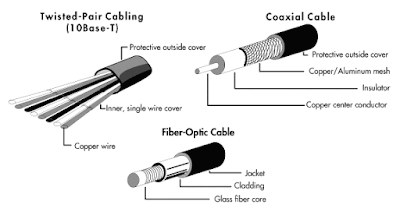Types of Network Transmission Media
BOUNDED (WIRED)
- Twisted pair wire
- Coaxial cable
- Fiber optic cable
UNBOUNDED (WIRELESS)
- Radio signals
- Satellite transmission
- Infrared transmission
What is cable ?
- Cable is the medium through which information usually moves from one network device to another.
Type of Cable?
COAXIAL CABLE
- Originally develop to carry large number of high-speed video transmission at one time.
- Shield of braided wire to block electromagnetic signals from entering the cable.
- Used in telephone transmission outside home and cable for television delivery
- More expensive than twisted pair but less susceptible to interference.
- Can carry more data quickly.
- Coaxial cable has a single copper conductor at its center.
FIBER OPTIC CABLE
- Consists of a center glass core surrounded by several layers of protective materials.
- Fastest delivery: able to transmit signals over much longer distances than coaxial and twisted pair.
- Transfers data represented by light pulses (billions of bit per second)
- Each strand: carry data for several television stations or thousands of voice and only send data in one direction.
- Example: Unifi
TWISTED-PAIR CABLE:
- Unshielded Twisted Pair (UTP)
- Has 4 pairs of wires inside the jacket.
- Each pair is twisted with different number of twists per inch to help eliminate interference from adjacent pairs and other electrical devices.
- A disadvantages: may be susceptible to radio and electrical frequency interference.
- Shielded Twisted Pair (STP)
- Two individual wires wrap in a foil shielding.
- Shielding to help provide a more reliable data communication.
- Suitable for environment with electrical interference.
- Disadvantage: Extra shielding cause bulky.
CABLE CONNECTOR
- Coaxial Cable Connector.
- The most common type of connector used with coaxial cables is the Bayonet-Neil-Concelman (BNC) Connector.
- Different types of adapters are available for BNC connectors, including a T-connector, barrel connector, and terminator.
- Fibre Optic Cable Connector
- The most common type of connector used with fiber optic cable is the ST & SC connector.
- UTP Cable Connector
- The standard connector for unshielded twisted pair cabling is an RJ-45 Connector. (RJ=Registered Jack)
- Look like a large telephone-style connector.
- A slow allows RJ-45 to be inserted only one way.
TOPOLOGY AND CABLE
Network Hardware/ Equipment
- File Server
- Workstation
- Network Interface Cards
- Concentrator/Hubs
- Switch
- Repeater
- Bridges
- Routers


Comments
Post a Comment